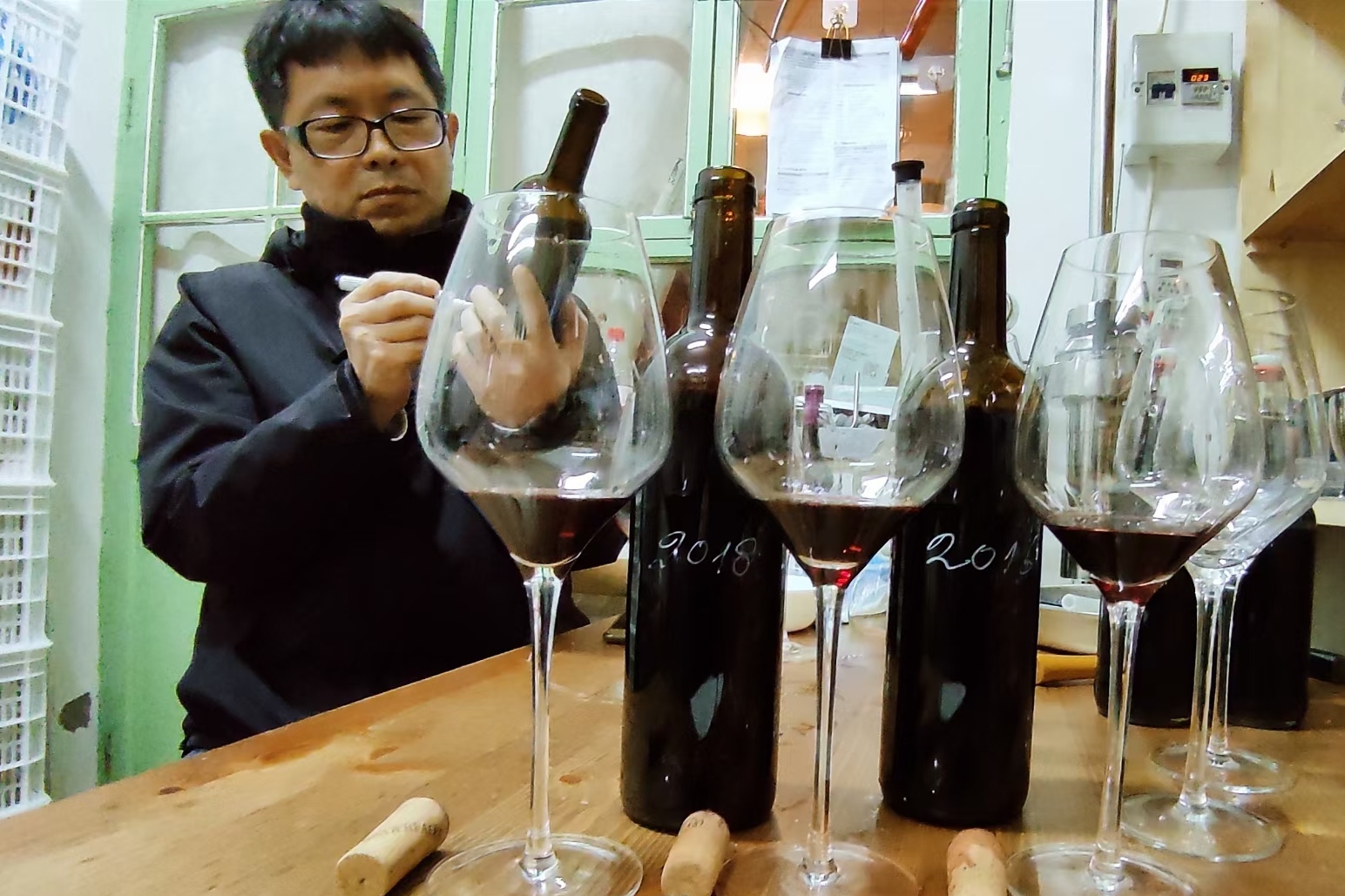Tasty Bordeaux blends made in Beijing’s hutongs?
A man named Zhang Bingzhai contacted me out of the blue a few years ago to say he was making wine, it turns out, down a secluded alley off a side street just a short walk from the Houhai Lake District and, in turn, Tiananmen Square.
Zhang’s message surprised me and the quality of his wines doubled that down: the word “passion” is thrown around (far too) casually in the wine trade but here was a guy living the life and doing it well. I made a much-overdue return visit two weeks ago.
Zhang, whose full-time gig is in the patent business, told me he first made wine in 1997: both a white (Semillon) and a red (Carignan) with fruit from Daxing in southern Beijing. And that he has been making wine at his current space since 2016.
In recent years, he has sourced fruit from Qingtongxia in Ningxia and Huailai County in Hebei, including varieties such as Cabernet Sauvignon, Cabernet Franc, Marselan, Merlot and Petit Verdot, although he dabbles in dessert wines, using Vidal grapes from northeast China, and in sparkling wines, including a recent Chardonnay he gave some oomph with aged ginseng and oyster shells.
His well-organized operation covers two rooms and is a master class in equipment sourcing. Over the years, he has pieced together a system that includes everything from a German press to French and American barrels to a Swiss corker. And he has used that system to pursue his own wine styles, which includes mixing vintages and grapes from different regions.
Here are some notes for his wines—that he bottles under the name Wanderfalke [peregrine falcon in German]—tasted during a fun afternoon session.
WF 2016. 60% Cabernet Sauvignon (Qingtongxia), 40% Merlot, Petit Verdot and Cabernet Franc (Huailai). Ample fruit and barrel influence—it was aged in new French oak for two years. Spicy dark cherry and plum aromas up front, then light chocolate and woody notes. After 30 minutes, the barrel influence grows, with hazelnut and chocolate aromas.
The wine is fresh and easy-going—I wrote down ‘delectable’—with a slightly grainy texture and a pleasant mouthfeel. It has a rustic feel, akin to a good thoughtfully cooked meal at someone’s home versus a restaurant’s set menu. There might be a few slight rough edges—for example, Zhang works off one barrel per vintage and can’t leverage blending like a winery—but that’s what makes it unique. I felt lucky to taste these wines.
WF 2018. 50% Cabernet Sauvignon (Qingtongxia), 50% Merlot and Cabernet Franc (Huailai). Darker, a deep garnet, and a bit ‘closed’ at first but it shared that dark fruit and subsequent chocolate aroma of the 2016 although there was more complexity as it opened, with nice herb and spice notes, including a touch of mint.
The body was tighter, and fresh and fruity, with nice acidity and texture. The oak influence—20 months in French barrel —really picks up as this wine breathes. I liked the freshness of the fruit.
(I later took a bottle to Pebbles Mexican restaurant and it turned out Shuai Zekun, who reviews Chinese wines, showed up that night. We tried the bottle together and he scored it pretty high.)
WF 2019. Zhang calls it a “super blend”: 40% Cabernet Sauvignon from Qingtongxia and 60%, Merlot, Cabernet Franc and Petit Verdot from Huailai.
Aromas of black cherry and toast but also a kind of curious forest woodiness. Milder, smoother and fuller than the first two, with the biggest ‘mouthfeel’. It feels you, like a work in progress.
WF 2021. 50% Cabernet Sauvignon, 25% Merlot and 12.5% each Cabernet Franc and Petit Verdot, all from Huailai. And with no sulfur.
This pours vibrant dark purple and smells like summer flowers (roses and violets) and tart fruit (hawthorn), with a spicy note from the American oak. Tight, quite tannic, slightly tart. Incredibly floral and with the acidity a bit rambunctious. It has only been in barrel a month and I hope to try it again soon.
We also tried a 2021 Marselan (Huailai), one month in barrel, that was inky purple and very tannic; a reserve I dubbed ‘super super blend” that featured four vintages (2016, 2017, 2018 and 2019), four grape varieties (Cabernet Sauvignon, Cabernet Franc, Merlot and Petit Verdot) and two regions (Qingtongxia and Hebei)—a special and aromatic wine, with ripe plum, tobacco and spices, that had a nice juiciness and umami edge; and a 2021 sparkling Chardonnay (Huailai).
That Chardonnay threw me. I initially thought it was an extra spicy Riesling or Gewurtztraminer. But it turned out Zhang found the wine bland and gave it oomph by adding 17-year-old ginseng from Changbai Mountain in Jilin province and oyster shells from Rushan in Shandong province to the tank. Unexpected! And weirdly appealing.
We finished with a sparkling rose Merlot Cabernet. And a stout: Zhang also makes beer. And then I headed back to the streets with a unique Sunday adventure and lots of delicious wine under my belt. I hope others get to try Zhang’s wine, too. Maybe it’s time for him to bring his wine out of the hutongs and into the world.
Grape Wall has no sponsors of advertisers: if you find the content and projects like World Marselan Day worthwhile, please help cover the costs via PayPal, WeChat or Alipay.
Sign up for the free Grape Wall newsletter here. Follow Grape Wall on LinkedIn, Instagram, Facebook and Twitter. And contact Grape Wall via grapewallofchina (at) gmail.com.
